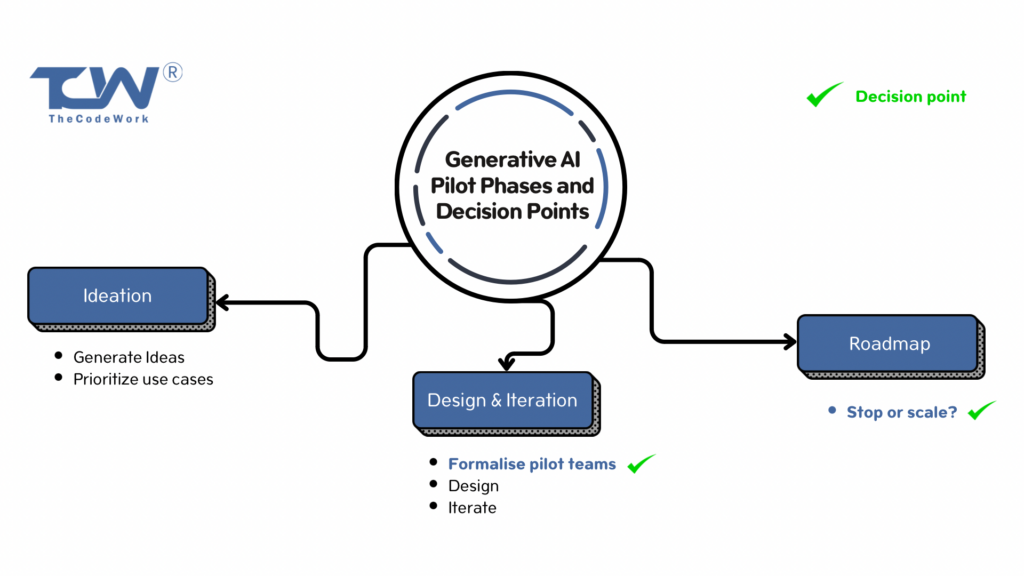Undoubtedly, Generative AI holds immense potential to transform business operations, yet its successful deployment depends on a structured pilot approach. Likewise, with a strategic approach in the early stages, businesses can make the right decisions to maximize impact.
Therefore, here’s a breakdown of the key phases and strategic points to guide you:

Phase 1: Generate Ideas
- Identify key business areas: Initiate with brainstorming on where AI can provide value, primarily focus on repetitive and data-heavy tasks.
- Align with business goals: Ensure that your AI initiatives directly support overarching strategic objectives for maximum impact.
Explore: Discover how our AI-driven solutions can streamline and elevate your business operations.
Phase 2: Prioritize Use Cases
- Evaluate feasibility: Then, assess your ideas based on data availability, resource needs, and expected ROI.
- Focus on high-impact use cases: Afterwards, select projects that align with your strengths and measurable outcomes.
Phase 3: Formalize Pilot Teams
- Assemble a cross-functional team: Include data analyst and scientists, subject matter experts, and AI-Project managers to ensure diverse expertise.
- Define roles and responsibilities: Likewise, set clear expectations to ensure smooth collaboration and accountability across all team members.
Phase 4: Design the Solution
- Understand data and model requirements: Tailor AI models as per your chosen use case,while ensuring compatibility with the available data and technology.
- Address ethical concerns: On the other hand, consider privacy, bias, and compliance check ups during the early phases to mitigate risks.
Related Article: Check out TheCodeWork®’s guide on IT Compliance and Regulations.
Phase 5: Iterate (Build, Refine, Test)
- Build and test prototypes: Start with a prototype to evaluate the model’s performance and functionality.
- Refine based on feedback: Then, continuously test and adjust the model using real-world data and user inputs to improve accuracy and relevance.
- Measure success: Also, define key performance indicators (KPIs) to assess effectiveness and guide refinement.
Phase 6: Create a Roadmap for Scaling
- Plan for infrastructure and resources: Finally, assess what needs to be scaled with your AI solution across the organization, like technology and staffing requirements.
- Develop training and support plans: Ensure that your employees are equipped to work with the new AI tools.
- Establish governance: Lastly, develop a framework for responsible AI use, addressing ethics, data privacy, and continuous oversight.
FAQs
Q1. How much time does a generative AI pilot typically take?
Ans: The duration varies depending on project complexity and resources but it generally takes several weeks to a few months. Subsequently, each phase—ideation, testing, and scaling—requires careful planning and time.
Q2. Is ongoing maintenance required for generative AI systems?
Ans: Yes, ongoing maintenance is essential for performance, ethical standards, and adapting to changes in business needs.
Contact TheCodeWork® today to start your AI transformation journey!
